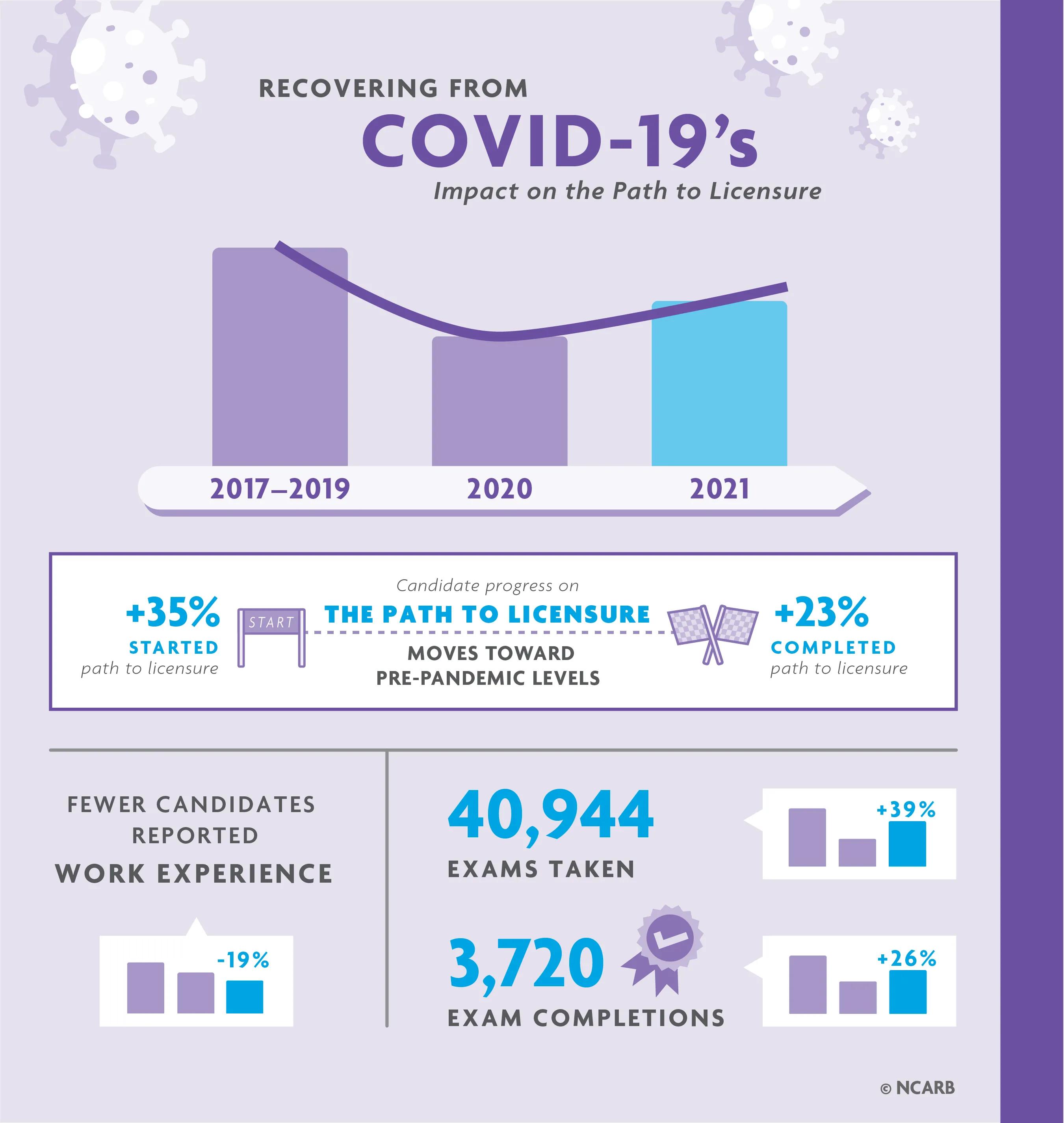
In 2020-2021, the COVID-19 pandemic impacted industries around the world—including architecture. NCARB’s data suggests that while the licensure pipeline is beginning to recover from the initial impact of the pandemic, some effects may continue to be felt for several years.

Throughout 2021, NCARB carefully tracked candidates’ progress through the Architectural Experience Program (AXP) and Architect Registration Examination (ARE)—as well as other key licensure metrics—to understand how the pandemic impacted their ability to meet career goals in real-time. This special report offers a month-by-month review of those key metrics, compared against numbers seen during the initial year of the pandemic (2020) and averages from the previous three years (2017-2019).
In April 2020, the number of candidates submitting AXP reports fell as COVID-19 began spreading throughout the United States.
In 2021, the number of candidates submitting experience reports each month returned to the pattern seen pre-pandemic, with spikes of AXP progress made in January and August. However, the number of candidates submitting reports each month remained lower than the average number seen pre-pandemic for the majority of the year (-4%).
Toward the end of 2021, the gap between the number of candidates reporting experience before the pandemic compared to the number seen in 2021 disappeared:
- In January 2021, 2,000 fewer candidates reported experience compared to the 2017-2019 average.
- By November 2021, more candidates were reporting experience than the average number seen in the three years prior to the pandemic.
This suggests that the pandemic’s impact on project demand, schedules, and day-to-day architecture work may be lessening.
With the launch of online proctoring in December 2020 and the increase in test center availability as COVID-19 precautions relaxed, exam deliveries returned to near-normal levels in 2021.
In 2020, less than 30,000 exams were delivered. In 2021, over 40,000 exams were delivered—still about 11,000 fewer (22%) than the average number delivered in the years leading up to the COVID-19 pandemic, but much closer to pre-pandemic numbers.
The number of new architects fell by 39% in 2020, compared to the three-year average seen prior to the COVID-19 pandemic. In 2021, the number of new architects began to recover, with nearly 4,000 individuals completing the path to licensure, a 23% increase from 2020. This number is still 24% fewer than the average seen in 2017-2019, however, suggesting a slow recovery from the effects of the pandemic.
Because completing the ARE is often candidates’ final step toward earning a license, the number of newly licensed architects aligns closely with the number of exam completions.
Creating an NCARB Record is often the first step on the path to licensure, because candidates use their Record to verify their education, document their professional experience, and take the licensing exam.
Just over 7,500 candidates started a new NCARB Record in 2021—10% fewer than the average number seen in the three years prior to the pandemic. Most of this difference is seen in the first half of 2021. In June 2021, the number of new Records created exceeded pre-pandemic levels and continued to align closely with the average 2017-2019 numbers for the remainder of the year.
The number of new Records typically peaks in January and June-August as college students open a Record to document professional experience earned over winter and summer breaks.
When architects apply for reciprocal (or out-of-state) licensure, NCARB reviews and sends their NCARB Record to the licensing board. In 2021, transmittals for reciprocal licensure applications exceeded the average number seen in the years prior to the pandemic by 22%.
Despite this, the annual Survey of Architectural Registration Boards showed that overall reciprocal licenses held in the United States fell slightly in 2021. This could be a result of architects giving up licenses held in certain states and pursuing new licenses in others, in order to pursue work in new locations based on project demand. Additionally, retiring architects sometimes allow their reciprocal licenses to lapse while maintaining their license in their home state.
